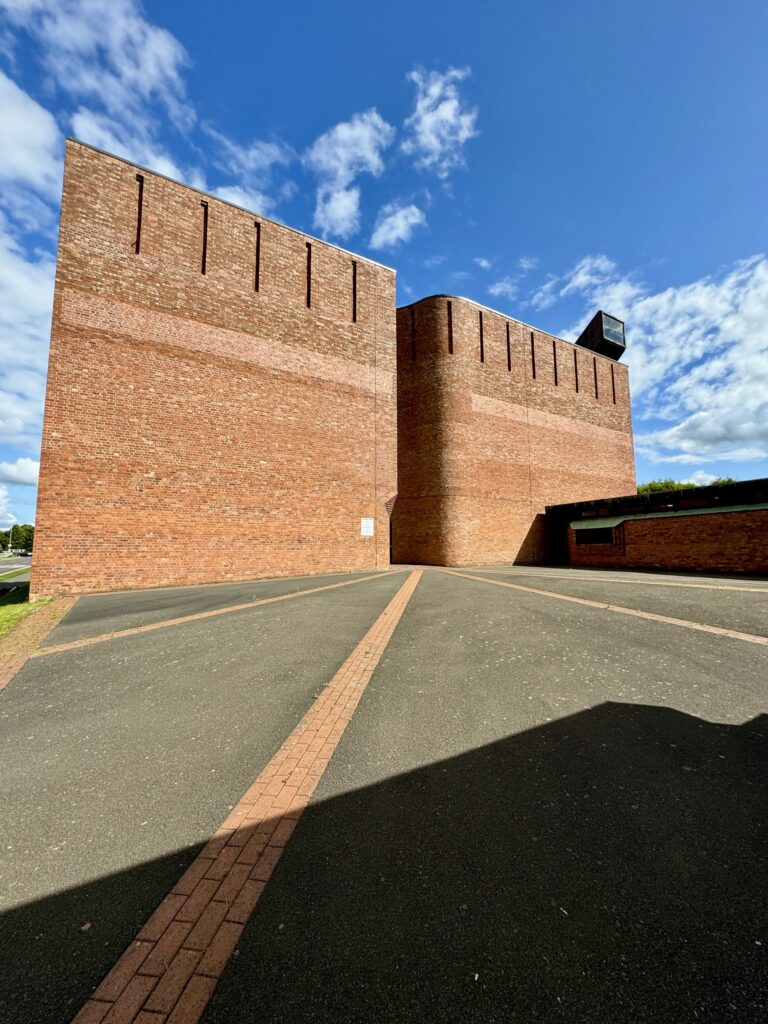Guest Post from Matthew Dransfield.
Matthew Dransfield, under the name @BrutalBasil, documents post-war modernist and brutalist architecture, from churches and swimming pools to pubs and housing schemes. He is passionate about photographing buildings before they are gone. His book Modernist Churches of Scotland was produced in partnership with The Modernist Society. His work has been published widely, including in The Guardian.
Churches are more than concrete, brick and glass and none more so than those created in postwar Scotland. In a relatively short span of time, Modernist architecture blossomed in ecclesiastical buildings across the Central Belt and beyond.
Take St Bride’s in East Kilbride: a gigantic red-brick fortress with barely a window. Or, in sharp contrast, the crisp white curves of Craigsbank Parish Church, which once had its own moat and can feel almost Mediterranean when the sun shines. I was told many of these churches were built without windows, cheaper to construct, and less chance of smashed glass.

The postwar housing boom drove this surge. As people left inner-city slums for spacious new suburbs, churches were needed to serve these communities. At no time before or since in Britain have so many been built so quickly. More than buildings, they are expressions of a historical moment, often hidden within council estates / housing schemes, visible only to those who live nearby.
As I explored them, I discovered both variety and daring. From the early 1950’s through the early 1960s, Scotland produced groundbreaking ecclesiastical architecture. It was a perfect storm: scarce materials, little standard guidance, small budgets, and an urgent demand. Architects were given space to experiment, and experiment they did.


St Andrew’s Catholic Church in Livingston is one striking result. Sitting high on its site, its swirling concrete form and angled roof recall Le Corbusier. In Glenrothes, St Paul’s Roman Catholic Church – now Category A listed, was the first major break from the traditional rectangular layout. Designed by Isi Metzstein and Andy MacMillan of Gillespie, Kidd & Coia, it pairs white concrete with jewel-like stained glass. This was their first church, and it set a radical new tone.
What is remarkable is not uniformity but diversity. Architects were encouraged to be bold, and their designs reflect the optimism, urgency, and sometimes desperation of the era. Churches had to be built fast, cheaply, and with modern flair.
Not everyone approved. One priest joked that when he reached the afterlife, he wanted a word with his architect: “They used rubbish materials. And Scotland is no place for flat roofs.” His frustration was understandable. Many churches were built under pressure, with steel shortages, experimental construction, and flat roofs that leaked in the Scottish rain. Some materials have aged badly, but that too is part of their story.

Today, half a century on, these churches face new challenges. Declining congregations mean closures, mergers, even demolition. Many lie abandoned or in poor repair, with little statutory protection and patchy listing. Concrete is rarely seen as nostalgic, and these buildings are not always loved.
Yet they remain beautiful in their own way. They capture a society in transition: communities moving from tenements into new estates, forging new identities in rapidly changing landscapes. The architecture reflects that turbulence and aspiration. For me, there is an urgent need to document them, to photograph them, and to argue for their reuse where possible.
Some dismiss Brutalism as ugly. I’d say: look again. These churches are cultural responses, symbols of optimism, change and faith in a new era.
Our thanks to Matt for sharing his reflections on our blog and at our launch symposium. You can find him on Instagram at @brutalbasil

